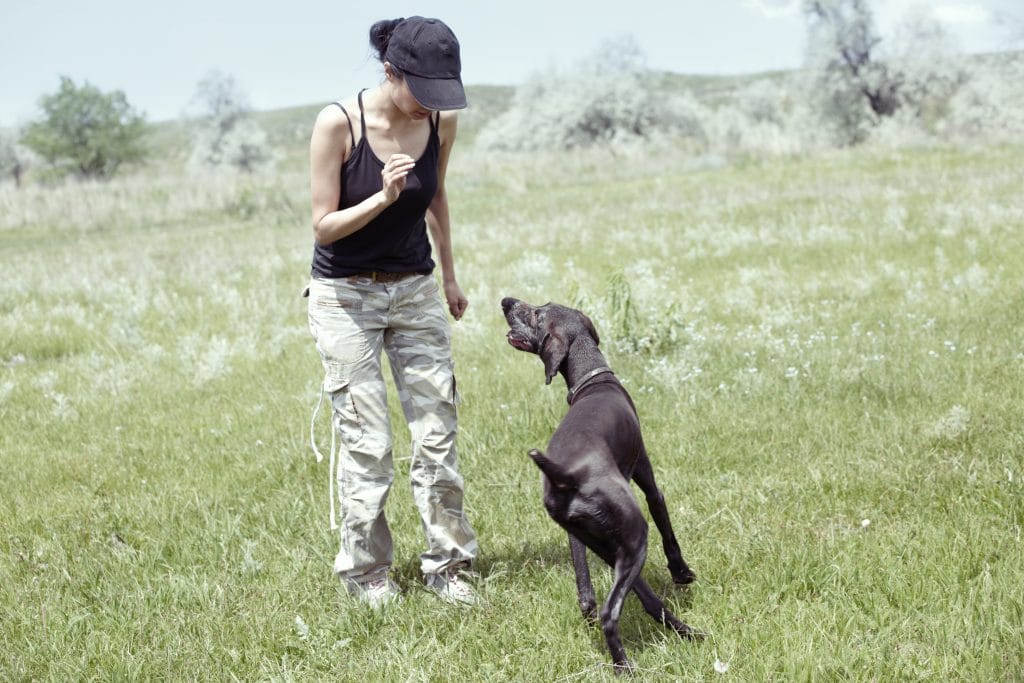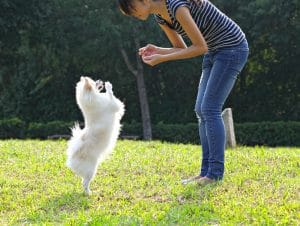![]()
HeelBoyHeel is reader supported. When you buy through any link on our site, we may earn an affiliate commission, but never at any extra cost to you.
People have been whistling their dogs for a very long time to communicate instructions, so dog whistle training is nothing new. However, by 1880 the first dog whistle had been invented, so folks who could not whistle were able to join in with dog whistle training.

Dog whistle training is usually associated with working dogs, sheep dogs, etc. However, the dog whistle is a very useful training tool for all dogs when used in conjunction with the verbal command.
What Is Whistle Training?
The dog whistle provides another form of communication between you and your dog. Another language for your best friend to get his or her head around! Although, maybe not so difficult for your dog as you think, due to his or her great hearing range. (You may have noticed how your dog will know someone is coming to your door, before you hear the doorbell.)
Whistle training teaches your dog to understand commands by the pitch and length of the whistle sound. Initially it must be used with vocal commands. It is particularly important that you are consistent with your whistle training. The same command must always be accompanied by the same pitch and length on the whistle. So, you have to devise and learn a new language as well!
The Advantages Of Dog Whistle Training
Long Distance Control
Even if you have a big booming voice that carries, the sound of the whistle will definitely carry far further. This is the reason that a working dog is trained to the whistle, so that he or she can receive instructions at a distance. The whistle has the ability to cut through loud noise, such as traffic or other pet owners trying to shout their dogs back, due to the whistle’s frequency range.
Consistency Is Key

All dog training relies on consistency. You know that If you have trained your pup to “sit” before you give him or her a biscuit, you ensure your pup does this every time.
Even though your dog may understand your command, (he or she is capable of learning around 150 words), your tone of voice may vary from time to time. This is particularly common with the “come” command, especially when your tone of voice changes and becomes a little frantic or angry as your best friend runs further away. Your dog will hear this change in tone. Not many of us would choose to run towards someone frantically or angrily shouting “come”!
However, the tone coming from the dog whistle will not change, no matter how stressed you get.
Ability To Share Responsibility
If you are reading this, then you may be the primary carer for a furry, family friend. He or she will hopefully respond to your instructions, but sometimes ignore the same instruction from other family members, especially younger members. Your dog is accustomed to your voice!
As the dog whistle emits the same sound every time, no matter who is blowing it, everyone can share in the responsibility that comes with having a furry friend.
How To Train Your Dog To Come Back Using A Whistle
There are a wide range of whistle commands you can train your dog to understand, however, the most useful is recall.
All whistle training must be accompanied with the voice commands that your dog already knows. Blowing a whistle and expecting your dog to understand what you want him or her to do is not going to happen.
To start with, use the whistle to alert your dog to supper time, a walk, a treat or anything that he or she enjoys. Your dog or pup needs to associate the sound of the whistle with something enjoyable. The next step is to use the whistle in your garden or yard. When your best friend is busy investigating an interesting “smell”, blow the whistle and say “come”. Every time your dog comes back to you, reward with dog treats and lots of fuss and praise. Yes, as with all positive dog training, dog treats are indispensable!

As your dog learns to associate the sound of the whistle with returning to you for a reward, you can extend the training sessions to more open spaces.
The Pros And Cons Of Dog Whistle Training
Pros
The main advantage of dog whistle training is that it is another form of communication between you and your dog, especially at long distances.
The whistle also has the advantage of not emitting the emotion you may be feeling, and, as previously said, enabling you to share the responsibility of looking after every ones favourite friend.
When your pup is young, you will be your puppy’s centre of attention. As your dog grows, so will his or her independence, making outside influences more interesting. The sound of the dog whistle has the ability to break your dog’s concentration on whatever he or she happens to be interested in. Therefore, making you the centre of your dog’s attention once again.
Cons
All dogs are different. Some dogs respond well to dog whistle training, however, some do not. In fact, in some cases the sound of the whistle can have adverse effects on the dog, even to the point of causing fear. This may be due to the dog’s hearing range or the quality of the whistle. Whatever the reason may be, the last thing you want is a fearful dog.
You have to make sure that you have the whistle with you at all times, consistency is key.
Why Whistle Training Works For Your Dog
Dog whistle training works for your dog for two reasons.
The first is positive association with the sound of the whistle. Rewarding your dog with fuss, attention and dog treats for the behaviour you want works for all dog training and whistle training is the same.
The second is your dog’s ability to hear the whistle more easily than a human voice at distance, helping him or her to do what you expect.
Things To Consider When Choosing A Dog Whistle
Your first consideration is that the dog whistle you choose must suit both you and your dog. You may have to try out more than one whistle to achieve this. Here are a few things for you to consider to help you with this.
Frequency Range
The dog whistle is a by-product of an invention to test the human hearing range. The inventor, Francis Galton, discovered that dogs (and cats) could easily hear much higher pitched sounds than humans. In fact, dogs have a high pitched range of frequency approximately two times higher than humans.
Most dog whistles are double the frequency you are able to hear, a silent whistle for you but not for your dog. This high frequency has the advantages of the sound of the whistle travelling long distances and your dog being able to recognise it. However, this sound is sharp for your dog and you may find that a lower frequency whistle is more comfortable for your dog. Watch for his or her reaction to the sound.
Strong Construction
There are many types of dog whistle for you to consider. The choice, as with most things, is down to how much you are able to or want to spend. However, no matter the price, the whistle must be durable. It is a false economy to buy a whistle that is not well made, you will only end up buying another one before too long.
Your relationship with your dog will last many years. As the whistle is an important form of communication between you and your dog, it is important that the whistle is strong. The whistle is going to be going on many long walks, probably dropped accidentally or sat on when in a back pocket.
With this in mind, metal whistles are stronger than plastic whistles.
Audible Whistles
You may be happier with an audible or loud whistle. Although this type of whistle’s sound will not carry so far as a silent dog whistle, it is better for a dog who is sensitive to a dog whistle with an ultrasonic range.
Conclusion
 Dog whistle training is a third string to your bow when training your pup or dog. Your new best friend is trying and willing to learn. Don’t miss the opportunity to introduce whistle training in conjunction with vocal commands and physical gestures. It can also be a very useful tool to reintroduce and inject new enthusiasm in an adolescent or older hound.
Dog whistle training is a third string to your bow when training your pup or dog. Your new best friend is trying and willing to learn. Don’t miss the opportunity to introduce whistle training in conjunction with vocal commands and physical gestures. It can also be a very useful tool to reintroduce and inject new enthusiasm in an adolescent or older hound.
As with all dog training, whistle training requires patience and consistency on your part and don’t forget the dog treats!
Frequently Asked Questions
Q. Is a dog whistle good for training dogs?
A. A dog whistle can be a great training tool for a dog, as long as you use it properly. With highly trained dogs, for example police dogs, it is common practice to train using a whistle. The reasoning behind it is that this high frequency it emits can travel far greater distances than a voice, and is less likely to scare wildlife or alert humans.
any whistle, it is best not to blow it continually directly into someone’s ear. In normal use there is no health risk.
Q. How expensive are dog whistles?
Typically they start at around $7 – $10. On the other end of the scale, the most expensive one has 47 diamonds stuck on it and cost $135,000! The best affordable ones retail for around $20 – you can see our selection of the best dog whistles here
Q. Do dog whistles hurt dogs?
No, dog whistles will not hurt dogs… as long as you don’t blow the whistle really close to your dog’s ears. Dogs do hear at a much higher frequency than humans, meaning that they are more sensitive to sounds, but if you use a dog whistle sensibly in the way it is supposed to be used, it will not hurt your dog at all.